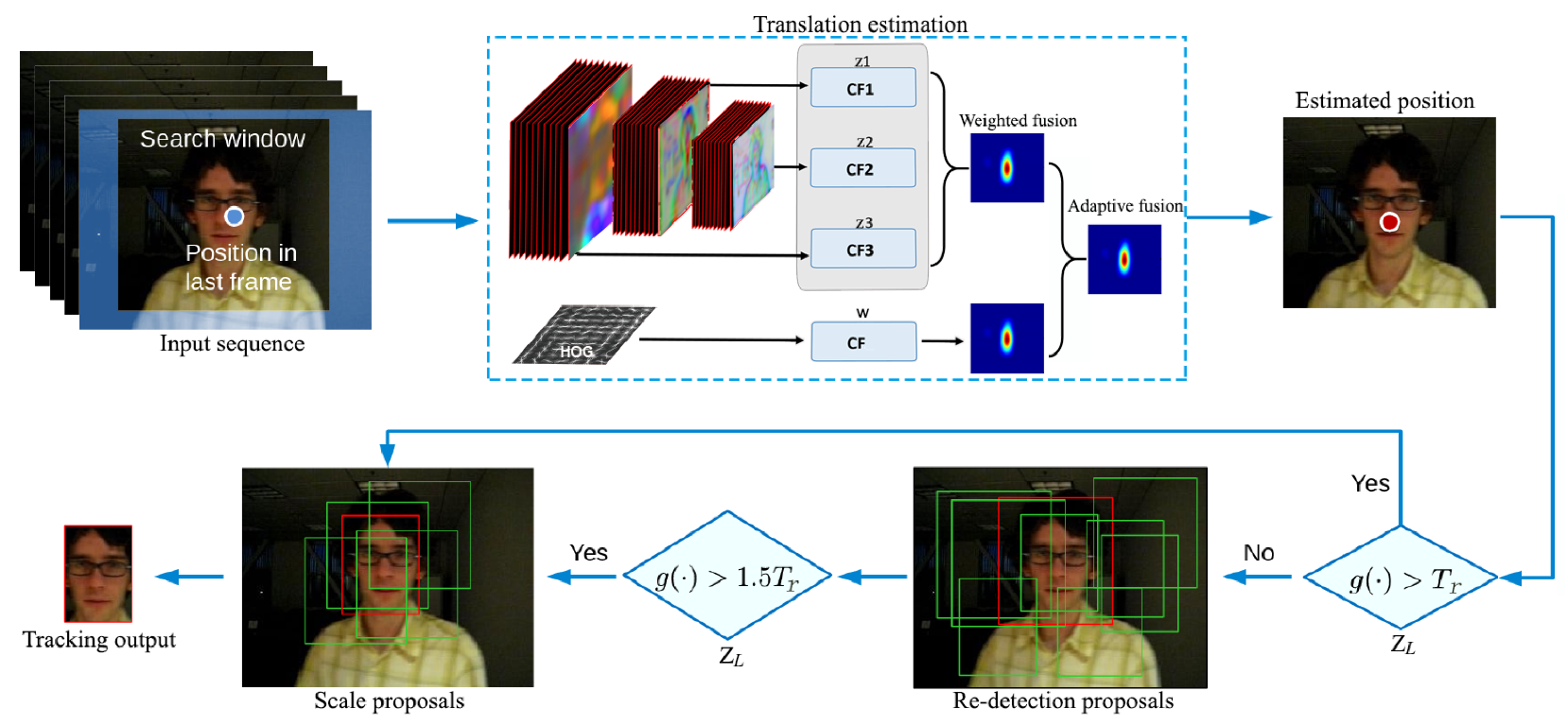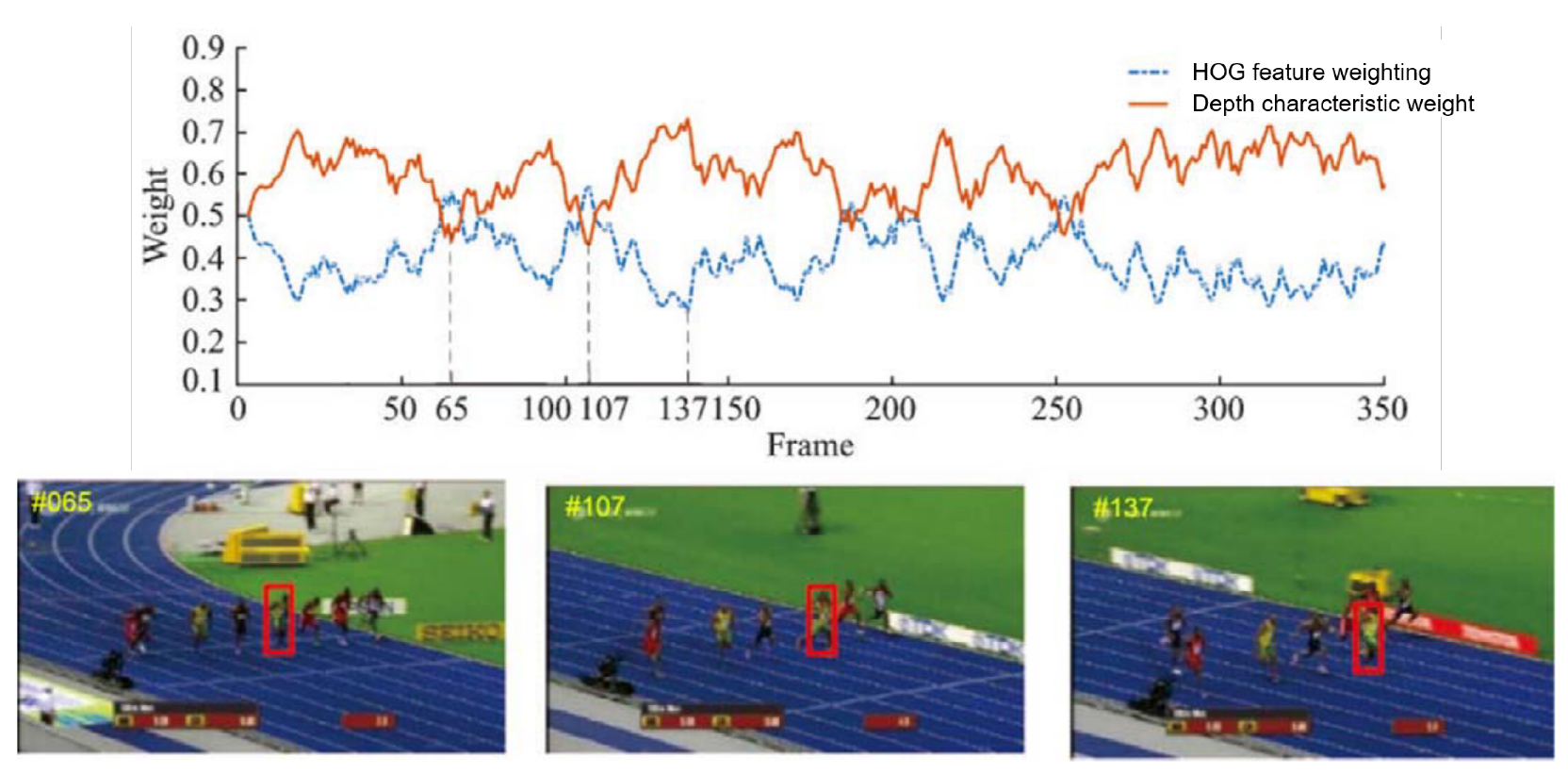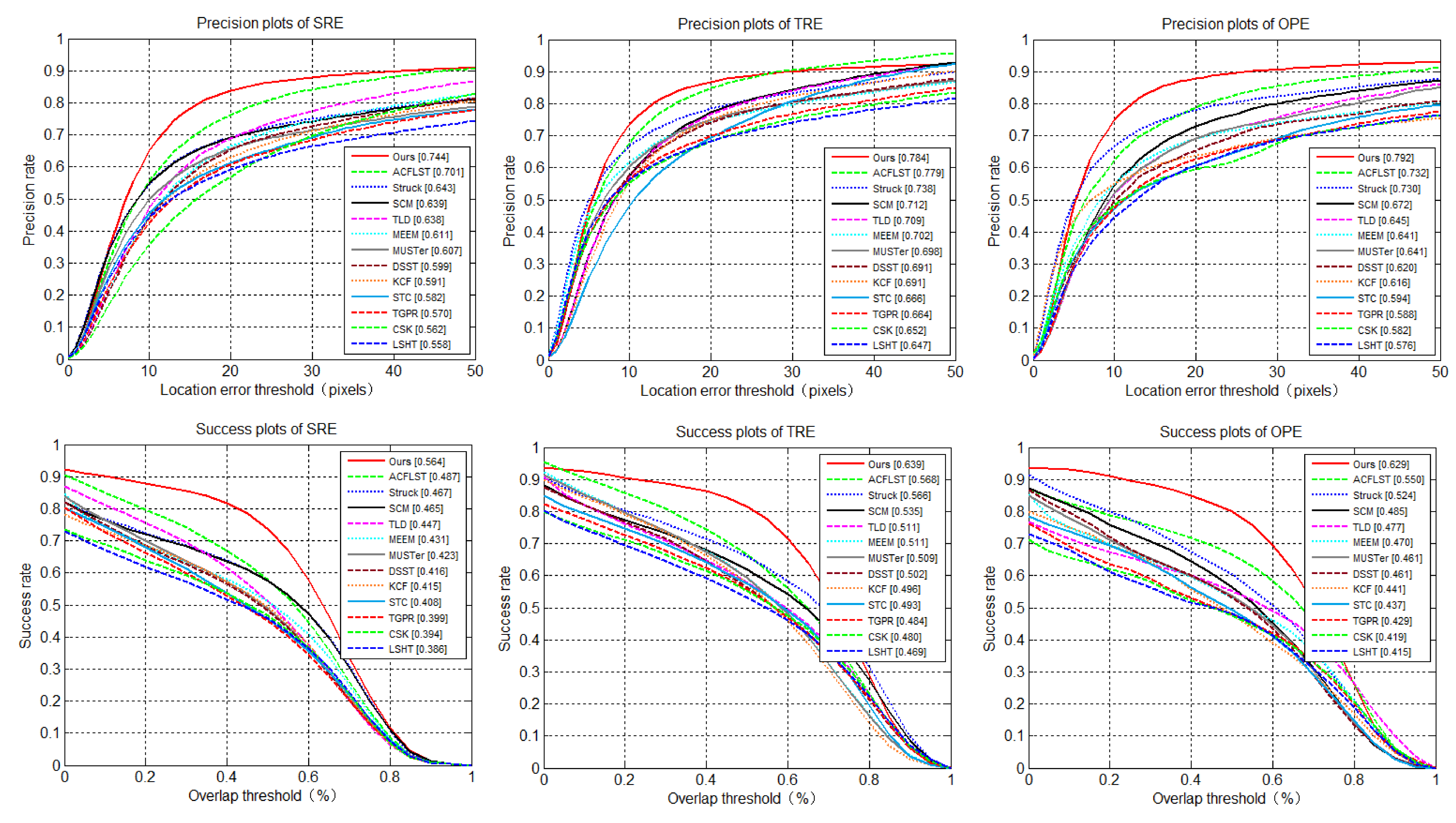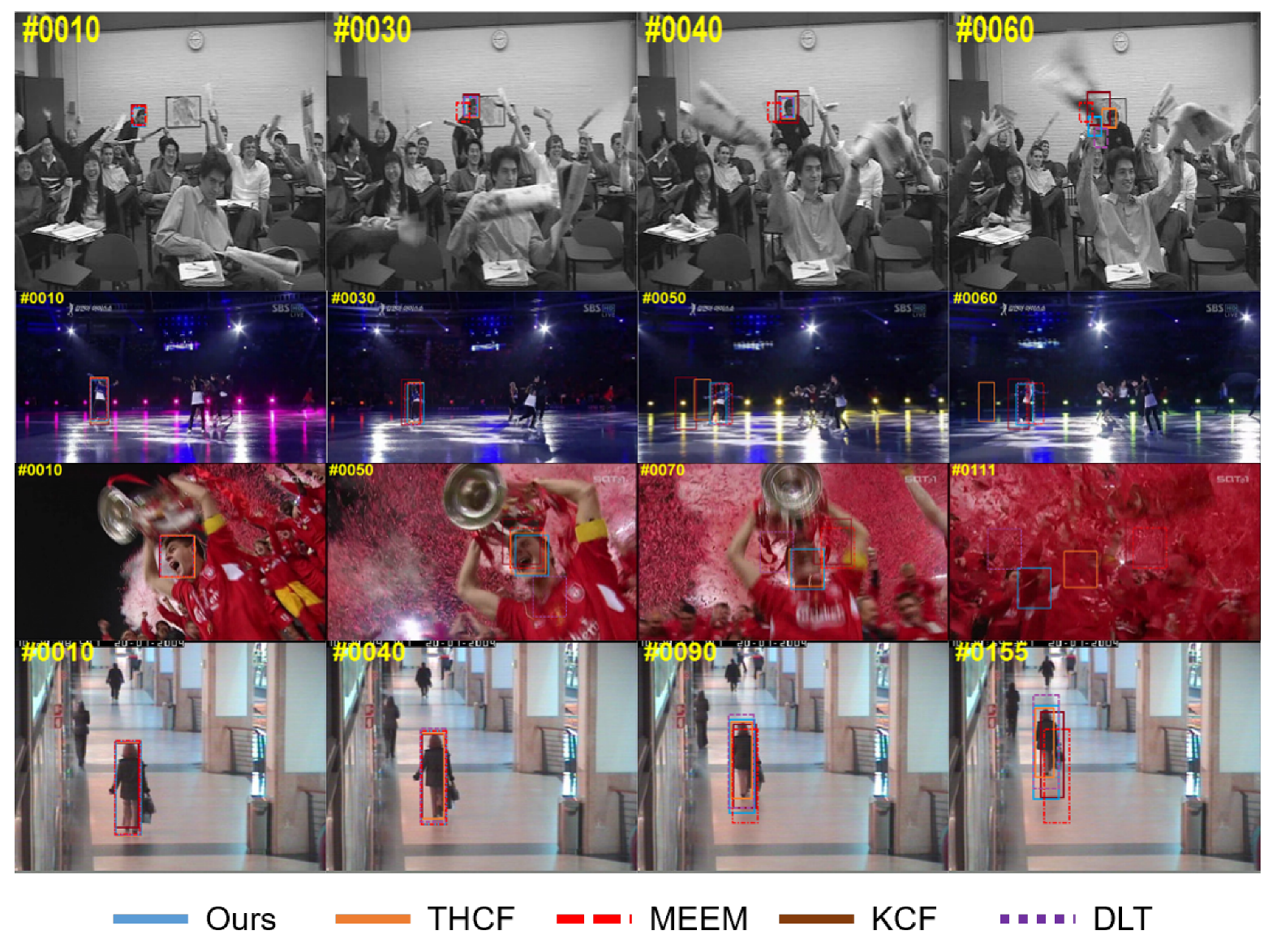Visual Tracking via Deep Feature Fusion and Correlation Filters
Abstract
1. Introduction
- Based on previous researches, we find that using the last layer of CNN can extract effective semantic information but not fine-grained spatial information, for example, the object location. On the other hand, the front-end layer of CNN is accurately positioned but not used to extract object semantics. Therefore, we use the rich feature levels of CNN as the target representation of visual tracking, and at the same time using semantic and fine-grained details to deal with the huge changes in appearance to avoid the drift and loss of targets
- Using the search strategy from rough to fine and the hierarchical characteristics of CNN research and the multi-level reasoning mechanism of classical computer vision to obtain the optimal tracking results, at the same time combining the correlation filter on each CNN layer to conduct adaptive learning while the multi-stage correlation filter is used to implement co-positioning, and make the target position be inferred from rough to fine [14].
- A plenty of experiments on large data sets which called OBT-100 [15] are tested, and the results of experiments show that our tracking algorithm is better than the existing methods in terms of accuracy and robustness.
2. Related Work
2.1. Original Detection Tracking
2.2. Tracking by Convolutional Neural Networks
2.3. Tracking by Correlation Filter and Multiple Feature Fusion Strategy
3. Overview
4. Proposed Methods
4.1. Region Proposal
4.2. Convolution Layer Feature Extraction
4.3. Convolution Target Location
4.4. Adaptive Convolution Feature Fusion
4.5. Appearance Model Update
4.6. Implementation Details
| Algorithm 1: Tracking algorithm with CNN and correlation filters |
 |
5. Experiments
5.1. Evaluation Metrics
5.1.1. Overlap Success Rate (OS)
5.1.2. Distance Precision (DP)
5.1.3. Center Location Error (CLE)
5.1.4. One-Pass Evaluation (OPE)
5.1.5. Temporal Robustness Evaluation (TRE)
5.1.6. Spatial Robustness Evaluation (SRE)
5.2. Overall Performance
- Deep learning tracker (DLT) [10];
5.3. Complex Scenario Evaluation
5.4. Component Modification Comparison Experiment
5.5. Layer Characteristic Difference Analysis
5.6. Evaluation Results Analysis
6. Conclusions
Author Contributions
Funding
Conflicts of Interest
References
- Liu, T.; Wang, G.; Yang, Q. Real-time part-based visual tracking via adaptive correlation filters. In Proceedings of the IEEE Conference on Computer Vision and Pattern Recognition, CVPR 2015, Boston, MA, USA, 7–12 June 2015; pp. 4902–4912. [Google Scholar] [CrossRef]
- Zhang, Y.; Tang, Y.; Fang, B.; Shang, Z. Fast multi-object tracking using convolutional neural networks with tracklets updating. In Proceedings of the International Conference on Security, Pattern Analysis, and Cybernetics, SPAC 2017, Shenzhen, China, 15–17 December 2017; pp. 313–317. [Google Scholar] [CrossRef]
- Shu, G.; Dehghan, A.; Oreifej, O.; Hand, E.; Shah, M. Part-based multiple-person tracking with partial occlusion handling. In Proceedings of the 2012 IEEE Conference on Computer Vision and Pattern Recognition, Providence, RI, USA, 16–21 June 2012. [Google Scholar]
- Ledig, C.; Heckemann, R.A.; Aljabar, P.; Wolz, R.; Hajnal, J.V.; Hammers, A.; Rueckert, D. Multi-class brain segmentation using atlas propagation and EM-based refinement. In Proceedings of the 2012 9th IEEE International Symposium on Biomedical Imaging (ISBI), Barcelona, Spain, 2–5 May 2012. [Google Scholar]
- Fiaz, M.; Mahmood, A.; Javed, S.; Jung, S.K. Handcrafted and Deep Trackers: Recent Visual Object Tracking Approaches and Trends. ACM Comput. Surv. 2019, 52, 43:1–43:44. [Google Scholar] [CrossRef]
- Yılmaz, A.; Javed, O.A.; Shah, M. Object tracking: A survey. ACM Comput. Surv. 2006, 38, 13. [Google Scholar] [CrossRef]
- Avidan, S. Ensemble Tracking. IEEE Trans. Pattern Anal. Mach. Intell. 2005, 29, 261–271. [Google Scholar] [CrossRef] [PubMed]
- Bai, Q.; Wu, Z.; Sclaroff, S.; Betke, M.; Monnier, C. Randomized Ensemble Tracking. In Proceedings of the IEEE International Conference on Computer Vision, ICCV 2013, Sydney, Australia, 1–8 December 2013; pp. 2040–2047. [Google Scholar] [CrossRef]
- Girshick, R.B.; Donahue, J.; Darrell, T.; Malik, J. Rich Feature Hierarchies for Accurate Object Detection and Semantic Segmentation. In Proceedings of the 2014 IEEE Conference on Computer Vision and Pattern Recognition, CVPR 2014, Columbus, OH, USA, 23–28 June 2014; pp. 580–587. [Google Scholar] [CrossRef]
- Wang, N.; Yeung, D. Learning a Deep Compact Image Representation for Visual Tracking. In Proceedings of the Advances in Neural Information Processing Systems 26: 27th Annual Conference on Neural Information Processing Systems 2013, Lake Tahoe, NV, USA, 5–8 December 2013; pp. 809–817. [Google Scholar]
- Wang, L.; Liu, T.; Wang, G.; Chan, K.L.; Yang, Q. Video Tracking Using Learned Hierarchical Features. IEEE Trans. Image Process. 2015, 24, 1424–1435. [Google Scholar] [CrossRef] [PubMed]
- Li, H.; Li, Y.; Porikli, F. DeepTrack: Learning Discriminative Feature Representations by Convolutional Neural Networks for Visual Tracking. In Proceedings of the British Machine Vision Conference (BMVC 2014), Nottingham, UK, 1–5 September 2014. [Google Scholar]
- Hong, S.; You, T.; Kwak, S.; Han, B. Online Tracking by Learning Discriminative Saliency Map with Convolutional Neural Network. In Proceedings of the 32nd International Conference on Machine Learning, Lille, France, 6–11 July 2015; pp. 597–606. [Google Scholar]
- Lucas, B.D.; Kanade, T. An Iterative Image Registration Technique with an Application to Stereo Vision. In Proceedings of the 7th International Joint Conference on Artificial Intelligence, Vancouver, BC, Canada, 24–28 August 1981; pp. 674–679. [Google Scholar]
- Wu, Y.; Lim, J.; Yang, M.H. Object Tracking Benchmark. IEEE Trans. Pattern Anal. Mach. Intell. 2015, 37, 1834–1848. [Google Scholar] [CrossRef] [PubMed]
- Ma, C.; Huang, J.; Yang, X.; Yang, M. Hierarchical Convolutional Features for Visual Tracking. In Proceedings of the 2015 IEEE International Conference on Computer Vision, ICCV 2015, Santiago, Chile, 7–13 December 2015; pp. 3074–3082. [Google Scholar] [CrossRef]
- Ramirez-Paredes, J.; Sánchez-Yáñez, R.E.; Ayala-Ramírez, V. A fuzzy inference approach to template-based visual tracking. Mach. Vis. Appl. 2012, 23, 427–439. [Google Scholar] [CrossRef]
- Kim, B.; Park, D. Novel target segmentation and tracking based on fuzzy membership distribution for vision-based target tracking system. Image Vis. Comput. 2006, 24, 1319–1331. [Google Scholar] [CrossRef]
- Li, L.; Xi-yang, Z.; Liu, Z.; Xie, W. Fuzzy logic approach to visual multi-object tracking. Neurocomputing 2018, 281, 139–151. [Google Scholar] [CrossRef]
- Babenko, B.; Yang, M.; Belongie, S.J. Robust Object Tracking with Online Multiple Instance Learning. IEEE Trans. Pattern Anal. Mach. Intell. 2011, 33, 1619–1632. [Google Scholar] [CrossRef]
- Grabner, H.; Leistner, C.; Bischof, H. Semi-supervised On-Line Boosting for Robust Tracking. In Proceedings of the 10th European Conference on Computer Vision, Marseille, France, 12–18 October 2008; Proceedings, Part I; Lecture Notes in Computer Science. Forsyth, D.A., Torr, P.H.S., Zisserman, A., Eds.; Springer: Berlin, Germany, 2008; Volume 5302, pp. 234–247. [Google Scholar] [CrossRef]
- Gao, J.; Ling, H.; Hu, W.; Xing, J. Transfer Learning Based Visual Tracking with Gaussian Processes Regression. In Proceedings of the Computer Vision—ECCV 2014—13th European Conference, Zurich, Switzerland, 6–12 September 2014; Proceedings, Part III; Lecture Notes in Computer Science. Fleet, D.J., Pajdla, T., Schiele, B., Tuytelaars, T., Eds.; Springer: Berlin, Germany, 2014; Volume 8691, pp. 188–203. [Google Scholar]
- Kalal, Z.; Mikolajczyk, K.; Matas, J. Tracking-Learning-Detection. IEEE Trans. Pattern Anal. Mach. Intell. 2012, 34, 1409–1422. [Google Scholar] [CrossRef]
- Zhang, J.; Ma, S.; Sclaroff, S. MEEM: Robust Tracking via Multiple Experts Using Entropy Minimization. In Proceedings of the Computer Vision—ECCV 2014—13th European Conference, Zurich, Switzerland, 6–12 September 2014; Proceedings, Part VI; Lecture Notes in Computer Science. Fleet, D.J., Pajdla, T., Schiele, B., Tuytelaars, T., Eds.; Springer: Berlin, Germany, 2014; Volume 8694, pp. 188–203. [Google Scholar] [CrossRef]
- Hare, S.; Saffari, A.; Torr, P.H.S. Struck: Structured output tracking with kernels. In Proceedings of the IEEE International Conference on Computer Vision, ICCV 2011, Barcelona, Spain, 6–13 November 2011; Metaxas, D.N., Quan, L., Sanfeliu, A., Gool, L.V., Eds.; IEEE Computer Society: Washington, DC, USA, 2011; pp. 263–270. [Google Scholar] [CrossRef]
- Sibbing, D.; Kobbelt, L. Building a Large Database of Facial Movements for Deformation Model-Based 3D Face Tracking. Comput. Graph. Forum 2017, 36, 285–301. [Google Scholar] [CrossRef]
- Ross, D.A.; Lim, J.; Lin, R.; Yang, M. Incremental Learning for Robust Visual Tracking. Int. J. Comput. Vis. 2008, 77, 125–141. [Google Scholar] [CrossRef]
- Zhao, Q.; Yang, Z.; Tao, H. Differential Earth Mover’s Distance with Its Applications to Visual Tracking. IEEE Trans. Pattern Anal. Mach. Intell. 2010, 32, 274–287. [Google Scholar] [CrossRef] [PubMed]
- Bolme, D.S.; Beveridge, J.R.; Draper, B.A.; Lui, Y.M. Visual object tracking using adaptive correlation filters. In Proceedings of the Twenty-Third IEEE Conference on Computer Vision and Pattern Recognition, CVPR 2010, San Francisco, CA, USA, 13–18 June 2010; IEEE Computer Society: Washington, DC, USA, 2010; pp. 2544–2550. [Google Scholar] [CrossRef]
- Henriques, J.F.; Caseiro, R.; Martins, P.; Batista, J.P. Exploiting the Circulant Structure of Tracking-by-Detection with Kernels. In Proceedings of the Computer Vision—ECCV 2012—12th European Conference on Computer Vision, Florence, Italy, 7–13 October 2012; Proceedings, Part IV; Lecture Notes in Computer Science. Fitzgibbon, A.W., Lazebnik, S., Perona, P., Sato, Y., Schmid, C., Eds.; Springer: Berlin, Germany, 2012; Volume 7575, pp. 702–715. [Google Scholar] [CrossRef]
- Henriques, J.F.; Caseiro, R.; Martins, P.; Batista, J. High-Speed Tracking with Kernelized Correlation Filters. IEEE Trans. Pattern Anal. Mach. Intell. 2015, 37, 583–596. [Google Scholar] [CrossRef]
- Danelljan, M.; Khan, F.S.; Felsberg, M.; van de Weijer, J. Adaptive Color Attributes for Real-Time Visual Tracking. In Proceedings of the 2014 IEEE Conference on Computer Vision and Pattern Recognition, CVPR 2014, Columbus, OH, USA, 23–28 June 2014; IEEE Computer Society: Washington, DC, USA, 2014; pp. 1090–1097. [Google Scholar] [CrossRef]
- Danelljan, M.; Bhat, G.; Khan, F.S.; Felsberg, M. ATOM: Accurate Tracking by Overlap Maximization. In Proceedings of the 2019 IEEE/CVF Conference on Computer Vision and Pattern Recognition (CVPR), Long Beach, CA, USA, 16–20 June 2019; pp. 4660–4669. [Google Scholar] [CrossRef]
- Wang, S.; Lu, H.; Yang, F.; Yang, M. Superpixel tracking. In Proceedings of the IEEE International Conference on Computer Vision, ICCV 2011, Barcelona, Spain, 6–13 November 2011; Metaxas, D.N., Quan, L., Sanfeliu, A., Gool, L.V., Eds.; IEEE Computer Society: Washington, DC, USA, 2011; pp. 1323–1330. [Google Scholar] [CrossRef]
- Ruan, Y.; Wei, Z. Real-Time Visual Tracking through Fusion Features. Sensors 2016, 16, 949. [Google Scholar] [CrossRef]
- Ma, C.; Huang, J.; Yang, X.; Yang, M. Robust Visual Tracking via Hierarchical Convolutional Features. IEEE Trans. Pattern Anal. Mach. Intell. 2019, 41, 2709–2723. [Google Scholar] [CrossRef]
- Dalal, N.; Triggs, B. Histograms of Oriented Gradients for Human Detection. In Proceedings of the 2005 IEEE Computer Society Conference on Computer Vision and Pattern Recognition (CVPR 2005), San Diego, CA, USA, 20–26 June 2005; IEEE Computer Society: Washington, DC, USA, 2005; pp. 886–893. [Google Scholar] [CrossRef]
- Zitnick, C.L.; Dollár, P. Edge Boxes: Locating Object Proposals from Edges. In Proceedings of the Computer Vision—ECCV 2014—13th European Conference, Zurich, Switzerland, 6–12 September 2014; Proceedings, Part V; Lecture Notes in Computer Science. Fleet, D.J., Pajdla, T., Schiele, B., Tuytelaars, T., Eds.; Springer: Berlin, Germany, 2014; Volume 8693, pp. 391–405. [Google Scholar] [CrossRef]
- Li, X.; Dick, A.R.; Wang, H.; Shen, C.; van den Hengel, A. Graph mode-based contextual kernels for robust SVM tracking. In Proceedings of the IEEE International Conference on Computer Vision, ICCV 2011, Barcelona, Spain, 6–13 November 2011; Metaxas, D.N., Quan, L., Sanfeliu, A., Gool, L.V., Eds.; IEEE Computer Society: Washington, DC, USA, 2011; pp. 1156–1163. [Google Scholar] [CrossRef]
- Simonyan, K.; Zisserman, A. Very Deep Convolutional Networks for Large-Scale Image Recognition. arXiv 2014, arXiv:1409.1556. [Google Scholar]
- Leichter, I.; Lindenbaum, M.; Rivlin, E. Tracking by Affine Kernel Transformations Using Color and Boundary Cues. IEEE Trans. Pattern Anal. Mach. Intell. 2009, 31, 164–171. [Google Scholar] [CrossRef]
- Danelljan, M.; Häger, G.; Khan, F.S.; Felsberg, M. Accurate Scale Estimation for Robust Visual Tracking. In Proceedings of the British Machine Vision Conference (BMVC 2014), Nottingham, UK, 1–5 September 2014. [Google Scholar]
- Galoogahi, H.K.; Sim, T.; Lucey, S. Multi-channel Correlation Filters. In Proceedings of the IEEE International Conference on Computer Vision, ICCV 2013, Sydney, Australia, 1–8 December 2013; IEEE Computer Society: Washington, DC, USA, 2013; pp. 3072–3079. [Google Scholar] [CrossRef]
- Boddeti, V.N.; Kanade, T.; Kumar, B.V.K.V. Correlation Filters for Object Alignment. In Proceedings of the 2013 IEEE Conference on Computer Vision and Pattern Recognition, Portland, OR, USA, 23–28 June 2013; IEEE Computer Society: Washington, DC, USA, 2013; pp. 2291–2298. [Google Scholar] [CrossRef]
- Chang-zhen, X.; Man-qiang, C.; Run-ling, W.; Yan, L. Adaptive Model Update via Fusing Peak-to-sidelobe Ratio and Mean Frame Difference for Visual Tracking. Acta Photonica Sin. 2018, 47. [Google Scholar] [CrossRef]
- Deng, J.; Dong, W.; Socher, R.; Li, L.; Li, K.; Li, F. ImageNet: A large-scale hierarchical image database. In Proceedings of the 2009 IEEE Computer Society Conference on Computer Vision and Pattern Recognition (CVPR 2009), Miami, FL, USA, 20–25 June 2009; IEEE Computer Society: Washington, DC, USA, 2009; pp. 248–255. [Google Scholar] [CrossRef]
- Wu, Y.; Lim, J.; Yang, M. Online Object Tracking: A Benchmark. In Proceedings of the 2013 IEEE Conference on Computer Vision and Pattern Recognition, Portland, OR, USA, 23–28 June 2013; IEEE Computer Society: Washington, DC, USA, 2013; pp. 2411–2418. [Google Scholar] [CrossRef]
- Vedaldi, A.; Lenc, K. MatConvNet—Convolutional Neural Networks for MATLAB. CoRR 2014. [Google Scholar] [CrossRef]
- Zhang, K.; Zhang, L.; Liu, Q.; Zhang, D.; Yang, M. Fast Visual Tracking via Dense Spatio-temporal Context Learning. In Proceedings of the Computer Vision—ECCV 2014—13th European Conference, Zurich, Switzerland, 6–12 September 2014; Proceedings, Part V; Lecture Notes in Computer Science. Fleet, D.J., Pajdla, T., Schiele, B., Tuytelaars, T., Eds.; Springer: Berlin, Germany, 2014; Volume 8693, pp. 127–141. [Google Scholar] [CrossRef]
- Zhang, K.; Zhang, L.; Yang, M. Real-Time Compressive Tracking. In Proceedings of the Computer Vision—ECCV 2012—12th European Conference on Computer Vision, Florence, Italy, 7–13 October 2012; Proceedings, Part III; Lecture Notes in Computer Science. Fitzgibbon, A.W., Lazebnik, S., Perona, P., Sato, Y., Schmid, C., Eds.; Springer: Berlin, Germany, 2012; Volume 7574, pp. 864–877. [Google Scholar] [CrossRef]
- He, S.; Yang, Q.; Lau, R.W.H.; Wang, J.; Yang, M. Visual Tracking via Locality Sensitive Histograms. In Proceedings of the 2013 IEEE Conference on Computer Vision and Pattern Recognition, Portland, OR, USA, 23–28 June 2013; IEEE Computer Society: Washington, DC, USA, 2013; pp. 2427–2434. [Google Scholar] [CrossRef]
- Zhong, W.; Lu, H.; Yang, M. Robust Object Tracking via Sparse Collaborative Appearance Model. IEEE Trans. Image Process. 2014, 23, 2356–2368. [Google Scholar] [CrossRef] [PubMed]
- Li, Y.; Zhu, J. A Scale Adaptive Kernel Correlation Filter Tracker with Feature Integration. In Proceedings of the Computer Vision—ECCV 2014 Workshops, Zurich, Switzerland, 6–7 September 2014; Proceedings, Part II; Lecture Notes in Computer Science. Agapito, L., Bronstein, M.M., Rother, C., Eds.; Springer: Berlin, Germany, 2014; Volume 8926, pp. 254–265. [Google Scholar] [CrossRef]
- Danelljan, M.; Häger, G.; Khan, F.S.; Felsberg, M. Discriminative Scale Space Tracking. IEEE Trans. Pattern Anal. Mach. Intell. 2017, 39, 1561–1575. [Google Scholar] [CrossRef] [PubMed]
- Krizhevsky, A.; Sutskever, I.; Hinton, G.E. ImageNet Classification with Deep Convolutional Neural Networks. In Proceedings of the Advances in Neural Information Processing Systems 25: 26th Annual Conference on Neural Information Processing Systems 2012, Lake Tahoe, NV, USA, 3–6 December 2012; pp. 1106–1114. [Google Scholar]








| Ours | THCF | MEEM | DLT | KCF | STC | Struck | SCM | CT | LSHT | CSK | MIL | TLD | ||
|---|---|---|---|---|---|---|---|---|---|---|---|---|---|---|
| [36] | [24] | [10] | [31] | [49] | [25] | [52] | [50] | [51] | [30] | [20] | [23] | |||
| DP rate | I | 79.2 | 83 | 79.4 | 54.8 | 74.1 | 54.7 | 65.6 | 64.9 | 40.6 | 56.1 | 54.5 | 47.5 | 60.8 |
| (%) | II | 71.6 | 78.1 | 71.3 | 52.6 | 69.2 | 50.7 | 63.5 | 57.2 | 35.9 | 49.7 | 51.6 | 43.9 | 59.2 |
| OS rate | I | 70.3 | 69.6 | 68.6 | 47.8 | 62.2 | 36.5 | 55.9 | 61.6 | 34.1 | 45.7 | 44.3 | 37.3 | 52.1 |
| (%) | II | 63.5 | 62.2 | 62.1 | 43 | 54.8 | 31.4 | 51.6 | 51.2 | 27.8 | 38.8 | 41.3 | 33.1 | 49.7 |
| CLE | I | 18.7 | 20.9 | 25.5 | 65.2 | 35.5 | 80.5 | 50.6 | 54.1 | 78.9 | 55.7 | 88.8 | 62.3 | 48.1 |
| (pixel) | II | 23.8 | 27.7 | 29.8 | 66.5 | 45 | 86.2 | 47.1 | 61.6 | 80.1 | 68.2 | 305 | 72.1 | 60 |
| Speed | I | 13.5 | 12.8 | 20.8 | 8.59 | 245 | 687 | 10 | 0.37 | 38.8 | 39.6 | 269 | 28.1 | 21.7 |
| (FPS) | II | 11.4 | 11.8 | 20.8 | 8.43 | 243 | 653 | 9.84 | 0.36 | 44.4 | 39.9 | 248 | 28 | 23.3 |
| Attributes | Ours | THCF [36] | MEEM [24] | DLT [10] | KCF [31] | STC [49] | Struck [25] | SCM [52] | CT [50] | LSHT [51] | CSK [30] | MIL [20] | TLD [23] |
|---|---|---|---|---|---|---|---|---|---|---|---|---|---|
| lllumination variation(23) | 72.0 | 72.1 | 70.2 | 61.7 | 58.3 | 57.5 | 56.5 | 34.4 | 41.1 | 47.4 | 53.9 | 28.0 | 43.2 |
| Out-of-plane rotation(37) | 78.6 | 74.7 | 73.1 | 66.4 | 61.2 | 62.1 | 58.2 | 36.9 | 43.5 | 50.4 | 57.8 | 35.1 | 45.7 |
| Scalvariation (28) | 67.5 | 69.5 | 68.8 | 56.9 | 47.2 | 46.3 | 50.8 | 32.8 | 34.0 | 47.9 | 61.7 | 34.5 | 48.7 |
| Occlusion(27) | 77.4 | 76.9 | 73.8 | 65.9 | 61.4 | 65.1 | 57.5 | 31.0 | 41.0 | 49.6 | 58.3 | 36.4 | 41.6 |
| Deforrnation(17) | 85.7 | 83.7 | 78.8 | 63.5 | 65.9 | 73.4 | 60.3 | 31.9 | 39.5 | 50.4 | 55.7 | 44.2 | 40.7 |
| Motionblur(12) | 65.8 | 66.4 | 66.7 | 65.5 | 54.8 | 58.0 | 52.4 | 21.3 | 34.3 | 50.0 | 32.1 | 23.4 | 48.2 |
| Fastmotion(17) | 67.6 | 67.3 | 65.7 | 67.4 | 49.5 | 55.1 | 49.7 | 21.4 | 36.7 | 55.1 | 32.6 | 32.7 | 45.9 |
| In-plane rotation(31) | 76.2 | 73.8 | 67.7 | 63.7 | 58.4 | 60.4 | 65.1 | 37.9 | 45.3 | 53.7 | 54.8 | 32.5 | 45.6 |
| Outofview(6) | 69.3 | 68.7 | 68.0 | 74.0 | 54.4 | 63.6 | 53.7 | 30.0 | 40.8 | 55.9 | 44.4 | 42.3 | 50.9 |
| Background clutter(21) | 75.5 | 75.4 | 75.5 | 72.1 | 66.5 | 67.9 | 59.7 | 37.7 | 47.9 | 53.5 | 53.6 | 40.3 | 39.8 |
| Low resolution (4) | 45.1 | 46.6 | 42.7 | 37.6 | 28.7 | 26.8 | 32.0 | 28.7 | 28.2 | 24.8 | 54.0 | 14.4 | 33.6 |
| Weighted Average | 73.9 | 73 | 70.6 | 64.3 | 57.6 | 59.8 | 56.7 | 32.9 | 40.8 | 50.5 | 53.2 | 34.3 | 44.5 |
| Attributes | Ours | THCF [36] | MEEM [24] | DLT [10] | KCF [31] | STC [49] | Struck [25] | SCM [52] | CT [50] | LSHT [51] | CSK [30] | MIL [20] | TLD [23] |
|---|---|---|---|---|---|---|---|---|---|---|---|---|---|
| lllumination variation (23) | 79.1 | 79.8 | 78.5 | 74.4 | 63.8 | 69.9 | 72.7 | 57.8 | 46.6 | 55.7 | 56.2 | 32.0 | 50.1 |
| Out-of-plane rotation (37) | 83.6 | 84.1 | 84.1 | 83.3 | 69.8 | 77.2 | 76.0 | 57.2 | 55.4 | 61.3 | 62.3 | 49.3 | 58.4 |
| Scal variation (28) | 76.7 | 84.5 | 82.5 | 77.6 | 62.6 | 68.6 | 75.7 | 56.5 | 49.9 | 65.0 | 66.3 | 47.5 | 60.5 |
| Occlusion (27) | 84.0 | 84.1 | 83.1 | 80.5 | 67.6 | 80.2 | 77.0 | 53.4 | 52.9 | 59.1 | 65.2 | 44.1 | 54.3 |
| Deforrnation (17) | 86.6 | 86.7 | 85.0 | 84.3 | 71.4 | 82.0 | 71.6 | 51.0 | 50.0 | 57.2 | 57.5 | 48.7 | 48.3 |
| Motion blur (12) | 67.6 | 68.6 | 70.5 | 72.1 | 54.2 | 66.2 | 59.9 | 32.3 | 35.2 | 55.5 | 35.2 | 34.8 | 51.0 |
| Fast motion (17) | 66.7 | 71.7 | 70.0 | 74.9 | 49.0 | 60.6 | 58.1 | 28.8 | 37.2 | 60.5 | 33.4 | 39.5 | 55.0 |
| In-plane rotation (31) | 80.8 | 81.6 | 79.7 | 81.1 | 69.0 | 73.2 | 78.2 | 53.1 | 54.6 | 63.5 | 60.5 | 45.2 | 60.0 |
| Out of view (6) | 73.5 | 72.8 | 72.7 | 72.3 | 51.0 | 66.3 | 53.3 | 41.2 | 37.2 | 55.3 | 44.5 | 39.2 | 57.3 |
| Background clutter(21) | 81.2 | 82.0 | 83.7 | 80.6 | 72.9 | 75.9 | 69.6 | 53.5 | 58.2 | 59.9 | 59.3 | 45.2 | 41.9 |
| Low resolution (4) | 72.4 | 75.7 | 76.4 | 90.4 | 44.0 | 63.3 | 74.0 | 50.9 | 46.4 | 55.3 | 66.0 | 32.5 | 56.4 |
| Weighted average | 79.3 | 81.1 | 80.4 | 79.4 | 64.9 | 73.0 | 72.2 | 51.3 | 50.1 | 60.1 | 57.5 | 43.6 | 54.5 |
| Ours | Ours_Deep | Ours_HOG | SAMF [53] | KCF [31] | DSST [54] | CN | |
|---|---|---|---|---|---|---|---|
| OS(%) | 64.3 | 60.9 | 59.3 | 57.8 | 55.7 | 52.9 | 49.3 |
| DP(%) | 85.8 | 85.4 | 72.2 | 70.7 | 68.2 | 67.1 | 60.2 |
| Ours | Vgg-Net-5 | VggNet-4 | VggNet-3 | VggNet-5-4 | VggNet-543 | AlexNet-5 | AlexNet-5-4-3 | AlexNet-5-4 | AlexNet-543 | |
|---|---|---|---|---|---|---|---|---|---|---|
| OS(%) | 64.3 | 56.7 | 54.9 | 52.4 | 55.7 | 52.2 | 49.5 | 47.5 | 47.2 | 46.9 |
| DP(%) | 85.8 | 84.7 | 78.3 | 72.5 | 84.8 | 77.4 | 67.4 | 66.5 | 65.9 | 65.7 |
© 2020 by the authors. Licensee MDPI, Basel, Switzerland. This article is an open access article distributed under the terms and conditions of the Creative Commons Attribution (CC BY) license (http://creativecommons.org/licenses/by/4.0/).
Share and Cite
Xia, H.; Zhang, Y.; Yang, M.; Zhao, Y. Visual Tracking via Deep Feature Fusion and Correlation Filters. Sensors 2020, 20, 3370. https://doi.org/10.3390/s20123370
Xia H, Zhang Y, Yang M, Zhao Y. Visual Tracking via Deep Feature Fusion and Correlation Filters. Sensors. 2020; 20(12):3370. https://doi.org/10.3390/s20123370
Chicago/Turabian StyleXia, Haoran, Yuanping Zhang, Ming Yang, and Yufang Zhao. 2020. "Visual Tracking via Deep Feature Fusion and Correlation Filters" Sensors 20, no. 12: 3370. https://doi.org/10.3390/s20123370
APA StyleXia, H., Zhang, Y., Yang, M., & Zhao, Y. (2020). Visual Tracking via Deep Feature Fusion and Correlation Filters. Sensors, 20(12), 3370. https://doi.org/10.3390/s20123370





